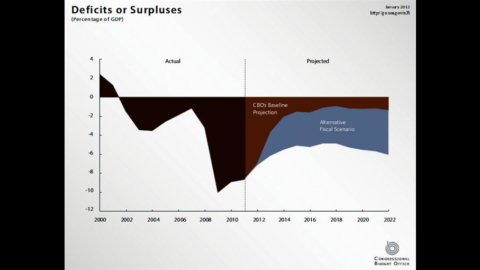The concept of tax cliff was born in the summer of 2011, to define the possible consequences of the agreement reached by the American political forces on cuts in public spending, 50% of which in the defense budget, and the cancellation of tax breaks for the middle and rich classes starting from next January. All to a value of about $500 billion in 2013 alone. And right now, just weeks into 2013, the problem ofAmerican public debt it seems all the more pressing. In 2012, the ratio of total public debt to GDP exceeded 104%, while the average deficit stood at 9% of GDP.
Lo studio by Davide Borsani published byISPI presents the double projection that the Congressional Budget Office (CBO) has offered on the effects that the impact of the fiscal cliff could have on public finances and on the American economy.
Il first scenario expects the cuts and tax increases to come into effect in January 2013. This way, already next year the federal deficit on GDP would decrease by four percentage points. At the same time, however, the economy would face a recession due to the drastic decrease in consumption and production. With the consequent increase in the unemployment rate, which would rise from the current 8% to 9%. The progressive increase in the tax burden at the federal level, which is currently equal to 15,7% of GDP, would lead to a gradual decline in the deficit, from 2,4% in 2014 to 0,4% in 2018. While the net federal debt would decrease by about 20 percentage points over 8 years, attracting flows of productive investments capable of driving, in the best forecasts, a economic growth of over 4% per year in the three-year period 2014-2017. And so the increase in goods and services produced would be reflected in the progressive decrease in unemployment, from 8,4% to 5,7%. Provided, however, that the cuts in public spending and the tax relief are distributed in such a way as not to suffocate the country's internal demand and productivity represented by the middle class.
Il second scenario instead, it assumes that public spending cuts are avoided by extending tax cuts indefinitely and indexing income taxes to inflation. In this context, a growth rate of around 1,7% is expected, continuing the status quo. Unemployment would remain unchanged at 8%, while the federal deficit would decrease by only a fifth ($100 billion) of what was budgeted, further fueling public debt. At this rate, according to forecasts, in the years between 2014 and 2022 the net federal debt would reach a new peak, rising by about 17 percentage points. This would lead to soaring interest rates on government bonds, causing a substantial reduction of private savings and investments.
Un unsustainable public debt, that is, when it exceeds a substantial percentage of GDP, it causes a loss of attractiveness for (local and foreign) investors and strong distortions on the accumulation process, jeopardizing the production of goods and services. In the in the event that the interest rate on sovereign bonds systematically exceeds the economic growth rate, in the medium-long term more and more money will have to flow from the pockets of debtors (the State and, therefore, citizens) to those of creditors. In this way price stability, the credibility of the fiscal and monetary authorities, and national solvency are undermined, while the difficulties in finding the necessary funds would increase more and more. As la economic dynamics would be at the mercy of cyclical fluctuations and speculation on the probability of default, without forgetting the repercussions that this scenario could have not only for the internal economy of the USA, but also for what it represents in the medium-long term for international trading partners.
A lesson for all those who, in Italy, are convinced that it is last year's efforts to consolidate public finances that represent the main obstacle to the country's growth and competitiveness and not their questionable distribution among social classes.





